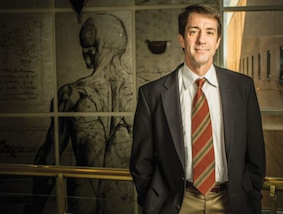Nature Profiles NCATS Director Christopher Austin
Christopher Austin leads NIH's bold new translational research centre NCATS.
Note: SC CTSI is part of the 60-institution CTSA consortium funded by NCATS and NIH.
In September, Christopher Austin, MD, was appointed as director of the fledgling National Center for Advancing Translational Sciences (NCATS) at the US National Institutes of Health (NIH) in Bethesda, Maryland.
In existence since December 2011, the centre has an ambitious — some say audacious — agenda that channels the central passion of both Austin and his boss, NIH director Francis Collins: to get more successful medicines into more patients, more quickly. That means forcing the agonizingly slow, failure-prone process of 'translational research' — the term of art for moving promising discoveries from the lab to the clinic — into a higher gear.

Passion runs high among the sceptics, too. Researchers both inside and outside the agency fear that NCATS — the first new centre at the NIH in more than a decade, funded at US$575 million last year — will encroach on a finite pot of money that they say would be better spent probing the mechanisms of basic biology and disease. Others question the scale of its mission. “With the available resources, how are you going to achieve this?” asks Thomas Caskey, a molecular geneticist at Baylor College of Medicine in Houston, Texas. “To me, you cannot just take this money and be another biotechnology company and you certainly don't have enough money to be a pharmaceutical company.”
One of Austin's major goals is to find a better way to use NCATS's biggest programme: the $461-million Clinical and Translational Science Awards (CTSAs), which fund around 60 translational-medicine centres, each operating independently.
NCATS will be neither, Austin responds. What will set it apart, he says, is a focus on overcoming obstacles on the road to drug development, from inadequate toxicology methods to inefficient clinical-trial recruitment, rather than actually producing the drugs. In an era in which more than 95% of drug candidates fail, and a novel drug takes 13 years and more than $1 billion to develop, “NCATS has to be focused on logarithmic improvements in the process”, says Austin. “You can't do this in a brute-force way. You have to do it differently. You have to drive the technology development.”
To underscore what sets NCATS apart from industry, Austin has been showcasing the centre's first new programme, which makes available to NIH-funded scientists 58 drugs tested in humans but abandoned by big drug firms for business reasons or because they didn't work against the conditions that the companies had tested them on. The goal is to put those candidates to other uses. The programme has become a useful flagship for NCATS not least because it — unlike others in the opaque field of translational research — is easily explained to the public.
Austin also likes to talk about NCATS's bid to overcome one of the biggest hurdles in the quest for new drugs: the discovery of harmful side effects when a compound is well into development. “This is a classic problem for NCATS to work on,” he says.
His solution, in part, is a programme in which NCATS is working with the Defense Advanced Research Projects Agency and the US Food and Drug Administration to put ten human tissues, from heart to brain and gut, on a chip that could then be used to screen potential drugs rapidly and efficiently for toxic effects. Another attack on toxicity can be found in the Tox21 programme, a collaboration between NCATS, the National Toxicology Program at the NIH's National Institute of Environmental Health Sciences and the Environmental Protection Agency. It began in December 2011 to screen 10,000 environmental chemicals and approved drugs against every known human signalling pathway, to identify which molecules might have toxic effects.
In the longer term, one of Austin's major goals is to find a better way to use NCATS's biggest programme: the $461-million Clinical and Translational Science Awards (CTSAs), which fund around 60 translational-medicine centres, each operating independently. The awards aim to train the next generation of translational researchers and to improve the full spectrum of that research, from discovering drug targets to answering health-delivery questions such as: do asymptomatic women really need routine manual pelvic exams? Since September, Austin has visited nine of the CTSA centres — he has planned six more visits — to talk to principal investigators and other staff members. While praising the centres' work, he says that they have so far mostly operated “without particular encouragement or direction from the NIH, and thus in a disjointed and uncoordinated fashion”. Austin wants to see a “CTSA 2.0” that will apply the consortium collectively to problems including clinical-trial recruitment, the development of better biomarkers and the rational use of electronic medical records in research. This can best be done “across a nationwide network focused on solving systematic problems”, says Austin.
Read more at Nature.com



